Related Research Articles
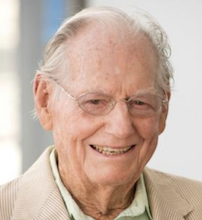
Morton Wayne Thiebaud was an American painter known for his colorful works depicting commonplace objects—pies, lipsticks, paint cans, ice cream cones, pastries, and hot dogs—as well as for his landscapes and figure paintings. Thiebaud is associated with the pop art movement because of his interest in objects of mass culture, although his early works, executed during the fifties and sixties, slightly predate the works of the classic pop artists. Thiebaud used heavy pigment and exaggerated colors to depict his subjects, and the well-defined shadows characteristic of advertisements are almost always included in his work.

Betty Parsons was an American artist, art dealer, and collector known for her early promotion of Abstract Expressionism. She is regarded as one of the most influential and dynamic figures of the American avant-garde.
Joan Takayama-Ogawa is a sansei (third-generation) Japanese-American ceramic artist and currently professor at Otis College of Art and Design in Los Angeles, California. Takayama-Ogawa's heritage since the 15th century of Japanese ceramic art influences her work, that usually explores beauty, decoration, ornamentation and narrative while also introducing a dialogue that rejects the traditional role of women in Japanese culture. Her most recent work addresses issues like climate change.
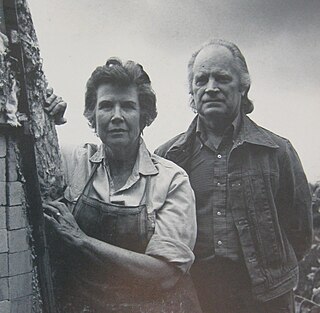
Otto Heino and Vivika Heino were artists working in ceramics. They collaborated as a husband-and-wife team for thirty-five years, signing their pots Vivika + Otto, regardless of who actually made them.
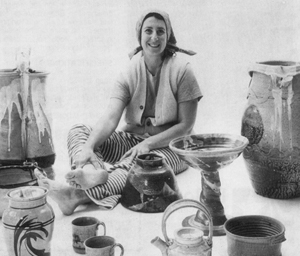
Elizabeth Woodman was an American ceramic artist.

Frans Wildenhain also known as Franz Rudolf Wildenhain was a Bauhaus-trained German potter and sculptor, who taught for many years at the School for American Craftsmen at the Rochester Institute of Technology in Rochester, New York.

Karen Karnes was an American ceramist, best known for her salt glazed, earth-toned stoneware ceramics.
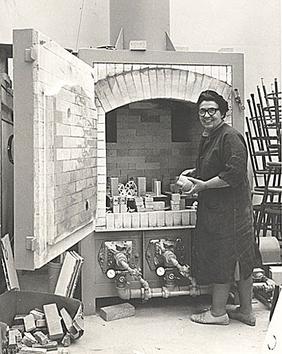
Laura Andreson was an American ceramic artist and educator at University of California Los Angeles.
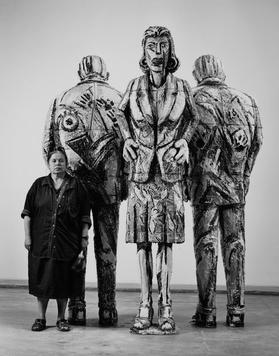
Viola Frey was an American artist working in sculpture, painting and drawing, and professor emerita at California College of the Arts. She lived and worked in the San Francisco Bay Area and was renowned for her larger-than-life, colorfully glazed clay sculptures of men and women, which expanded the traditional boundaries of ceramic sculpture.
Patti Warashina is an American artist known for her imaginative ceramic sculptures. Often constructing her sculptures using porcelain, Warashina creates narrative and figurative art. Her works are in the collection of the Museum of Arts and Design, New York, National Museum of Modern Art, Kyoto, and the Smithsonian American Art Museum.

Senga Nengudi is an African-American visual artist and curator. She is best known for her abstract sculptures that combine found objects and choreographed performance. She is part of a group of African-American avant-garde artists working in New York City and Los Angeles, from the 1960s and onward.
Betty Feves (1918–1985) was an Oregon artist who helped shape the development of clay as an expressive medium in the years following World War II.

Catherine Elizabeth Cooke is an American designer whose career has lasted more than 73 years. She is principally known for her jewelry. She has been called "an icon within the tradition of modernist jewelry" and "a seminal figure in American Modernist studio jewelry". Her pieces have been shown nationally and internationally and are included in a number of museum collections, including the Museum of Modern Art (MOMA) in New York. She is regarded as an important role model for other artists and craftspeople.
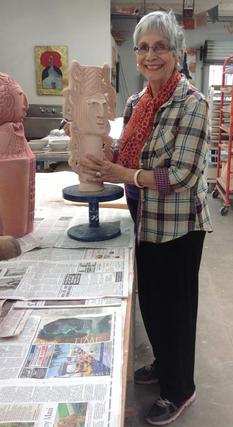
Dora De Larios was an American ceramist and sculptor working in Los Angeles. She was known for her work's clean lines and distinctive glazes, as well as for her line of tableware created under her family-run company Irving Place Studio. Also a muralist working with tile, De Larios was noted for her style, which reflects mythological and pan-cultural themes.

Hisako Shimizu Hibi (1907–1991) was a Japanese-born American Issei painter and printmaker. Hibi attended the California School of Fine Arts in San Francisco, California where she garnered experience and recognition in the fine arts and community art-exhibition. Here, she met her husband George Matsusaburo Hibi, with whom she raised two children, Satoshi "Tommy" Hibi and Ibuki Hibi.
Lia Cook is an American fiber artist noted for her work combining weaving with photography, painting, and digital technology. She lives and works in Berkeley, California, and is known for her weavings which expanded the traditional boundaries of textile arts. She has been a professor at California College of the Arts since 1976.
Karen Thuesen Massaro is a ceramicist working in the United States known for creating unconventional arrangements of sculptural objects through her work. Interested in exploring abstraction, she has experimented with a variety of different themes including the repetition of forms and surface textural change, negative space, and the geometric patterning of natural objects. Massaro creates much of her artwork by taking casts of physical objects, like fruit, molding them out of clay, and decorating them with patterns. Her manipulations make common objects feel less ordinary. These experiments allow her to explore color and form in complex ways.
Nan Bangs McKinnell (1913–2012) was an American ceramicist and educator. Nan was a founding member of the National Council on Education for the Ceramic Arts, a member of the American Craft Council College of Fellows, along with receiving several awards for her work. James "Jim" McKinnell (1919–2005), her spouse, was also a ceramicist and they made some collaborative work.

Nancy Selvin is an American sculptor, recognized for ceramic works and tableaux that explore the vessel form and balance an interplay of materials, minimal forms, and expressive processes. She emerged in the late 1960s among a "second generation" of Bay Area ceramic artists who followed the California Clay Movement and continued to challenge ceramic traditions involving expression, form and function, and an art-world that placed the medium outside its established hierarchy. Her work has been exhibited at the Los Angeles County Museum of Art (LACMA), Denver Art Museum, Daum Museum of Contemporary Art and Kohler Arts Center, and belongs to the public art collections of LACMA, the Smithsonian Institution, Oakland Museum of California, and Crocker Art Museum, among others. Critic David Roth has written, "Selvin's position in the top rank of ceramic artists has come through a process of rigorous self-examination … what differentiates [her] is that she eschews realism and functionality, indicating a level of intellectual engagement not always found among ceramicists." Writer and curator Jo Lauria described Selvin's tableaux as "elegiac and stylistically unified" works that serve as "forceful essays on the relationship between realism and abstraction, object and subject, decoration and use." Selvin lives and works in the Berkeley, California area.
Nina de Creeft Ward is an American artist who works with bronze, soft sculptures, etchings, woodcuts, and monoprints. She had multiple art exhibitions in the Philippines and the United States. Ward was the co-winner of the Individual Artists Award for Works in Clay in 2006 from the Santa Barbara Arts Fund. Most of Ward's work has to do with animals, including a 1998 exhibition of art that resembled endangered and extinct species. She has taught students such as at the University of Northern Iowa. Her clay animal models are made with raku ware.
References
- 1 2 Granahan, Andrea (July 4, 2012). "Hot dogs, ice cream cones and art". Press Democrat. Retrieved 19 July 2013.
- 1 2 3 "Betty Spindler". Smithsonian American Art Museum. Smithsonian Institution. Retrieved 19 July 2013.
- 1 2 3 "Betty Spindler". Cerro Coso Community College Alumni. Cerro Coso Community College. Retrieved 19 July 2013.
- ↑ Camille Gavin (February 10, 2006). "Theater takes stab at wacky 'Robin Hood'". Bakersfield Californian. Retrieved July 29, 2013.
- ↑ "Hot Dog by Betty Spindler". Smithsonian American Art Museum. Smithsonian Institution. Retrieved 19 July 2013.
- ↑ Ruth Justis (July 1, 2012). "Open Studio Tour - Betty Spindler". Ridgecrest News. Retrieved 19 July 2013.
- ↑ "Betty Spindler | Smithsonian American Art Museum". americanart.si.edu. Retrieved 2022-03-07.